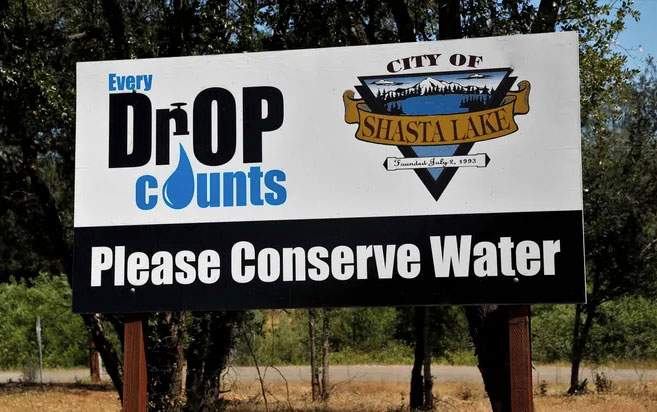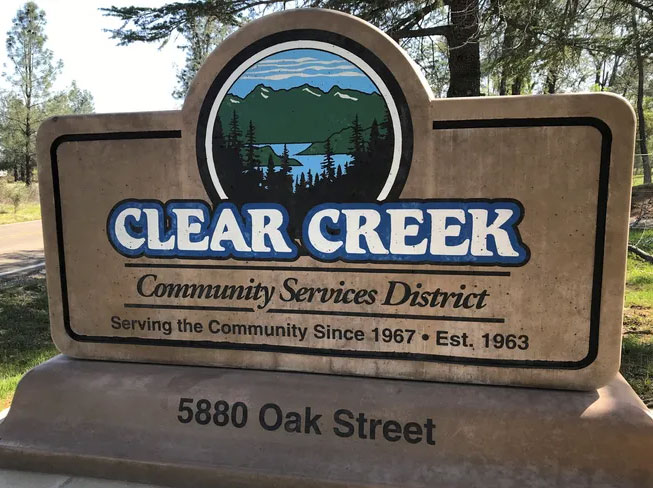By Damon Arthur Via Redding Record Searchlight
Lake Shasta this summer is facing possibly its lowest level in at least 44 years, and that could be bad news for the people who rely on it for drinking and irrigation water, as well as endangered salmon that depend on it to survive.
Dam operators have to go all the way back to 1977 to compare how bad this year’s water situation is shaping up to be, said Don Bader, area manager for the U.S. Bureau of Reclamation, which manages the dam.
“It’s dry. It’s second worst, so far. It’s probably going to exceed ’77. But the kicker is in ’77 we didn’t have all the requirements that we have now,” Bader said.
The bureau is scrambling to figure out how to stretch the limited supply in the lake to meet the needs of cities and farms up and down the state that rely on water from the lake, as well as endangered salmon that need the water to survive downstream in the Sacramento River, Bader said.
Bureau reduces water deliveries to local communities
In addition, Redding and several surrounding communities and water districts indirectly get their water from Lake Shasta.
Because of the drought and low lake level, several of those communities have already had their water allocations from the bureau reduced about 45%.
And the 20,000 residents served by the Bella Vista Water District — which serves an area from northeast Redding to Palo Cedro and Bella Vista — face penalties if they don’t reduce water usage 10%.
The city of Shasta Lake also had its allocation cut 45%, but the city has an agreement to purchase water from the Anderson Cottonwood Irrigation District to compensate for the cutback, City Manager John Duckett said.

The Clear Creek Community Services District, which provides water to Happy Valley residents, also had its allocation reduced 45%, but the district plans to pump groundwater and purchase water to make up for the bureau reductions, according to Irwin Fust, vice chairman of the district board of directors.
Shasta Lake and Clear Creek are not imposing mandatory cutbacks on their customers.
Because it has an older, more senior water right, the city of Redding’s allocation has not been cut as severely, and no mandatory conservation measures have been imposed in the city, said Chuck Aukland, public works director.
Redding also has numerous groundwater wells to make up for cuts in water from the bureau, Aukland said.

Fish and wildlife in line to receive water
But the bureau’s obligations go beyond supplying water to cities and farms.
Dam operators also need to make sure there is enough cold water for wildlife that live downstream, including endangered winter-run chinook salmon, which require cold water from the lake to lay and hatch eggs in the Sacramento River from Redding to Red Bluff.
Dam operators use a temperature control device on the back side of the dam, which enables them to release water from different depth levels in the lake. Water from deeper in the lake is colder and is used to make sure the eggs and recently hatched baby salmon (called fry) don’t die.
During the last drought — in 2014 and 2015 — the lake ran low on cold water and some 90% of the salmon eggs in the river perished because the water was too warm.
Jon Rosenfield, senior scientist for the San Francisco Bay Keeper, said the number of salmon eggs killed this year could be similar to 2014 and 2015.
A study from the National Oceanic and Atmospheric Administration’s Southwest Fisheries Science Center tends to support that. The study says that more than 80% of the salmon eggs in the river could die this summer as a result of warm water in the Sacramento River.
The eggs and recent hatches generally need water at least 56 degrees or colder to survive, fisheries officials said.

Rosenfield said he would like to see the Bureau of Reclamation hold more water behind the dam to prevent a mass die-off of salmon eggs. If the bureau held another 500,000 acre-feet of water, it could increase egg and young salmon survival by about 30%, he said.
Earlier this month the bureau released warmer water from the lake to preserve colder water for later this summer, Bader said.
Warm water releases stress endangered salmon
However, the warmer water — up to around 60 degrees some days — put under stress the winter-run that had already arrived in the Sacramento River in the Redding area, Rosenfield said.
The fish had already traveled hundreds of miles from the ocean to get back to their spawning grounds, he said.
More stress from warm water further depletes their energy and makes it more difficult for them to make nests in the gravel in the river so they could spawn, he said.
Jason Roberts, an environmental program manager with the California Department of Fish and Wildlife said the fish “didn’t respond well” to the warmer water temperature.
Water from Shasta flows into Keswick Lake and then is released into the Sacramento River from Keswick Dam.
“There’s probably thousands of fish right below Keswick dam, which is highly unusual,” Roberts said. “So the fishery agencies told reclamation last week that the power bypass was probably negatively affecting the winter-run chinook and we recommended that they stopped bypassing power and reduce river temperatures down to 57 degrees.”
By this week the temperatures had dropped back down to the mid-50s, Bader said. He said 90% of the water being sent downstream this week was from lower in the lake, he said.

How conditions in Lake Shasta got so bad
While bureau officials try to find a way to stretch lake water through the dry season, John McManus, executive director of the Golden State Salmon Association, said he wondered how conditions at the lake got so bad.
“As recently as 2019 we had a wet winter. Our reservoirs were full,” McManus said. “What in the world happened in two years to put us into this predicament? Or put differently, the fact that we had a wet winter, as recently as two years ago, and now we’re bone dry, tells you quite a bit about how water managers go about their job here in California.”
The salmon association represents commercial fishermen, who are affected by the fate of the winter-run salmon.
McManus said that when the number of winter-run salmon counted in the rivers and ocean drop to low levels, state and federal regulators reduce the area where commercial fishermen can operate and the amount of fish they are allowed to catch.
The bureau’s Bader said the lake may have been full two years ago, but 2021 marks the second-straight year of low rainfall in the North State.
Earlier this year the bureau was predicting it would see another 680,000 acre-feet of water flow into Lake Shasta this spring from snowmelt and rain storms, he said.
However, conditions were so dry that snowmelt and rain soaked into the ground, rather than running off into streams and into the lake, he said.
“We’d see a rainstorm and nothing, the lake would just sit there. We’re used to seeing that thing come up to 2 to 3 feet in a good storm,” he said.
As of Tuesday, Shasta Lake was at 54% of average for the date and Trinity Lake was at 62% of average, according to the bureau.
The rainfall total at Shasta Dam was just under 24 inches since Oct. 1, according to the California Department of Water Resources. The previous record for low rainfall was 24 inches in 1977, Bader said.
“Things have just fallen off the cliff in the last six weeks. So that’s where we are now. Day to day, they’re making all kinds of decisions down in Sacramento about what can we do to salvage the rest of the season,” Bader said.
